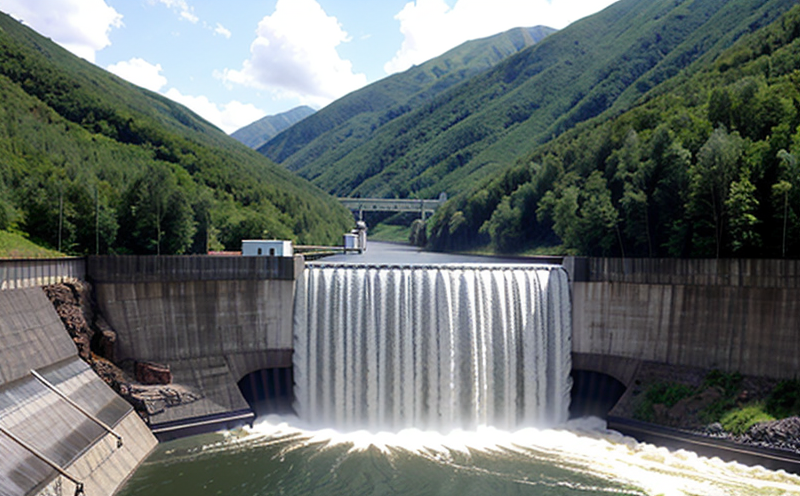Hydropower & Turbine System Testing
In the realm of renewable energy, hydropower stands as one of the most reliable and efficient sources of electricity. Hydropower systems consist of turbines and generators that convert the kinetic energy of flowing water into mechanical or electrical power. Ensuring the reliability, safety, and efficiency of these systems is critical for sustainable development. This service page will provide comprehensive information on testing hydropower and turbine systems.
Hydropower systems are subject to harsh environmental conditions and can face various challenges such as sediment accumulation, corrosion, and mechanical wear over time. Therefore, rigorous testing ensures that turbines operate efficiently under these conditions and meet international standards. The tests include performance evaluations, material integrity checks, and environmental impact assessments.
The testing process involves several key steps: initial inspection of the turbine components to ensure they are in good condition; disassembly where necessary for detailed examination; testing using advanced instrumentation such as hydrodynamic testers, fatigue testers, and acoustic emission detectors; and finally, reassembly followed by final performance checks. These tests help identify potential issues early on, ensuring that hydropower systems remain safe and efficient throughout their operational lifecycle.
Testing standards for hydropower turbines are set out in various international norms including ISO 13598:2007, ISO 14066, and ASTM D7142. Compliance with these standards not only ensures quality but also enhances the reputation of the manufacturer or installer.
- ISO 13598:2007 specifies requirements for the design, manufacture, installation, commissioning, operation, maintenance and decommissioning of hydropower plants. It includes guidelines on safety aspects, environmental impact considerations, and quality assurance measures.
- ISO 14066 provides a framework for managing greenhouse gas emissions in relation to renewable energy projects like hydropower. This helps operators comply with regulatory requirements related to carbon accounting practices.
- ASTM D7142 deals specifically with the testing methods used for hydraulic turbine runners, blades, and other components. It covers aspects such as dimensional measurements, surface finish evaluation, mass determination, and more.
The importance of this service cannot be overstated given its role in maintaining sustainable energy production. By adhering to strict testing protocols, we contribute significantly towards reducing environmental footprints while enhancing operational efficiencies. This aligns perfectly with broader goals aimed at promoting green technologies worldwide.
Why Choose This Test
Selecting hydropower & turbine system testing is essential for several reasons:
- Ensures Safety: Regular inspections and tests help prevent accidents by identifying potential hazards before they become critical issues.
- The use of advanced monitoring technologies allows continuous surveillance of key parameters such as temperature, pressure, vibration levels, etc., ensuring optimal performance.
- Data collected during testing provides insights into how efficiently water is being converted into electricity. Engineers can then make informed decisions about adjustments needed in the system configuration or operational parameters.
- International standards like ISO 14066 emphasize the importance of transparency and accountability when it comes to managing GHG emissions. Adherence to these guidelines can lead to enhanced trust among stakeholders including investors, customers, and regulatory bodies.
In summary, choosing hydropower & turbine system testing ensures not only compliance with legal obligations but also contributes positively towards achieving sustainability targets set forth by global organizations such as the United Nations Framework Convention on Climate Change (UNFCCC).
Quality and Reliability Assurance
The cornerstone of any successful hydropower project lies in its ability to deliver consistent, reliable power output. Ensuring this reliability involves several key aspects:
- Material Integrity: Testing materials used in the construction of turbines helps confirm their suitability for long-term use under extreme conditions.
- Samples taken from different parts of a turbine are subjected to various tests including tensile strength, ductility, and wear resistance. These tests ensure that all components can withstand prolonged exposure to water, sediment, and mechanical stress without degradation.
- Performance Evaluation: Evaluating how efficiently energy is being converted from one form to another under real-world conditions provides valuable data for optimizing system performance.
- Field trials are conducted where actual turbines are deployed in operational environments to measure their efficiency, power output, and overall reliability over extended periods. Such evaluations help pinpoint areas requiring improvement or replacement.
- Maintenance Schedule Optimization: Understanding the expected lifespan of various components allows for more accurate scheduling of maintenance activities.
- Based on test results, operators can develop customized maintenance schedules that balance cost against downtime and safety. For instance, certain parts may require less frequent inspections compared to others due to their lower risk of failure or higher durability ratings.
The goal is always to maximize uptime while minimizing expenses associated with repairs or replacements. By focusing on these quality assurance practices, we can help maintain the integrity and efficiency of hydropower systems for years to come.
Environmental and Sustainability Contributions
- Reduction in Carbon Footprint: Hydropower is considered a clean energy source because it produces little or no greenhouse gas emissions during operation. However, the construction phase does generate some CO₂ emissions which can be offset through various means such as planting trees.
- Biodiversity Preservation: Properly designed hydropower projects minimize impacts on local ecosystems by creating buffer zones around reservoirs and implementing fish ladders to allow migration upstream.
- Economic Benefits: Investing in robust testing infrastructure supports job creation both directly within the industry itself as well as indirectly through related sectors like manufacturing and consulting services.
In conclusion, hydropower & turbine system testing plays a crucial role in supporting sustainable development by enhancing reliability while reducing environmental impacts. It is an integral part of our commitment to fostering cleaner energy solutions that benefit society at large.





